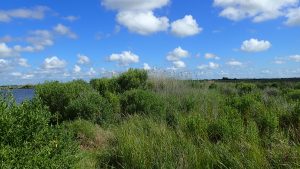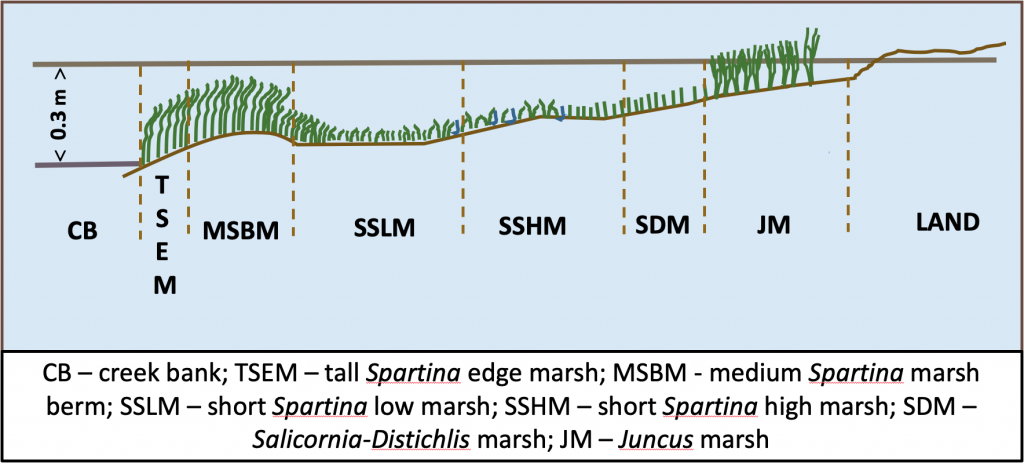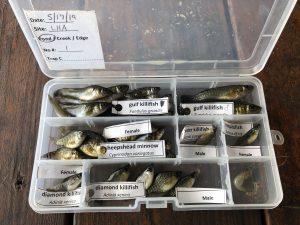Salt marshes are intertidal vegetated wetlands that are flooded and drained by waters brought in by the tides. They are the interface between supratidal land and the waters of estuaries, where salinity may vary between nearly fresh to marine, and sometimes hypersaline. In the U.S., salt marshes occur on every coast, with approximately half of the nation’s salt marshes being located along the Gulf of Mexico coastline.
Marsh Flora and Fauna

Salt marsh plants occupy different salinities along the estuary and with site different marsh platform elevation and distance from tidal waters. The composition of salt marsh plants is maintained by the natural ebb and flow of tidal waters across the marsh platform. Salt marsh vegetation, at least in medium salinity regimes, is composed primarily of smooth salt grass (Spartina alterniflora), black rush or needlerush (Juncus roemerianus), and seashore saltgrass Distichlis spicata). Transition into higher terrestrial habitats and into fresher environments leads to primary occupation of marsh hay cordgrass (Spartina patens). As the tidal waters become more brackish and almost fresh, the plants become much more diverse.
Tidal flux brings estuarine and near-shore fish and crustaceans to the marsh to complete their life histories, while some marsh fish and crustaceans are resident, for example, many killifish and mummichogs and grass shrimp. These marsh species are noted for their hardiness and ability to tolerate highly variable salinity, temperature fluctuations from 6 to 35 °C, low oxygen levels (down to 1 mg l-1), and polluted ecosystems. The more obvious epibenthic species include fiddler crabs of several species, periwinkle snails, Melampus and Neretina snails, ribbed mussels, and paper mussels. Larger animals are alligators, snakes such as salt marsh snakes and speckled king snakes, and the Gulf coast terrapin. Mammals include mink, muskrats, nutria (an invasive species), and marsh rice rats. Larger marine mammals, such as bottle-nosed dolphins, can be seen fishing the shallow shorelines adjacent to salt marshes by forcing fish into the shallow water and capturing them.
Marsh Ecosystem Services
Salt marshes are essential for healthy fisheries, coastlines, and communities. They generate many ecological and economic services:

- Food and refuge for resident and migratory organisms, including nursery areas for many commercially and recreationally important fish and shellfish. A provisioning aspect of salt marshes is the support of fisheries. Seafood us an integral part of Gulf coast culture in the form of fish, such as red drum and speckled sea trout, blue crabs and stone crabs, white and brown shrimp, and oysters. The commercial and recreational fishing industries for these animals contribute millions of dollars to the coastal economy and employ thousands of people. These resources are also important to individual fishers and subsistent fishers for recreation and sustenance.
- Multiple habitats for coastal bird populations and terrestrial mammals and reptiles. Salt marshes are the home of many resident and migratory bird species, including clapper rails, bitterns, many herons, the seaside sparrow, sea gulls and terns, and brown pelicans, night herons and roseate spoonbills where higher elevation brush is available. Waterfowl, resident and migratory make their homes in salt marshes. Alligators, river otters, Gulf coast terrapins, mink, muskrats and nutria (an invasive species) call these marshes their home. Smaller ribbed mussels, paper mussels, neretina snails, coffee bean snails, marsh crabs, blue crabs, killifish, and periwinkles are also integral to salt marshes. The plants and animals interact to form a highly productive ecosystem with high diversity, that provides support of higher trophic levels, including humans, and recreational amenities.
- Shoreline protection against wave-induced erosion. Living shorelines, such as oyster reefs and salt marshes, dampen the wave energy of storm surges, in normal conditions, cold front passage, and times of hurricanes and tropical storms. The America’s Water Infrastructure Act of 2018 requires the U.S. Army Corps of Engineers (USACE) to consider ‘soft’ solutions, when planning to coastal flood protection.
- Shoreline protection through trapping and accumulation of sediment. Salt marsh plants facilitate sediment accretion by decreasing current velocities and allowing sediment to settle out of suspension. Current velocities are reduced as the stems of tall marsh plants induce hydraulic drag, with the effect of minimizing re-suspension of sediment and encouraging deposition.
- Filtration of pollutants and improvement of water quality. A healthy salt marsh has the ability to reduce pollutants. Excess nutrients and chemicals are filtered out and can be taken up by salt marsh plants and stored in their roots and rhizomes as well as broken down by bacteria in the marsh sediments. When nutrient inputs exceed what is ‘normal’ for a salt marsh, the nutrients may cause deterioration of the below-ground vegetation through microbial decomposition and eventual loss of the marsh edge and platform.
- Provision of aesthetic ecosystem amenities. Salt marshes provide an area to enjoy boating, fishing, bird watching, hunting, crabbing, and oystering for recreational activities. The salt marsh resources vary through the seasons providing an annual diversity of wildlife.
- Protection against storm surges. Salt marshes, and often their associated oyster reefs, play an important role in minimizing damage from storm surge on the coastal salt marsh habitat. The salt marsh habitat acts as a barrier that helps to reduce wave energy and current velocity. The natural buffering of the salt marsh helps protect upland areas, including private property from flooding and erosion during storms.
- Sequestration of carbon dioxide, a greenhouse gas, and conversion into living plant material with subsequent decomposition, (i.e., a control for climate change). These coastal plants can sequester 100 times more carbon than forests. Since there are tens of thousands of acres of salt marsh in the southeastern U.S. and along the Gulf of Mexico, this makes them a significant sink for atmospheric CO2 (https://www.saltmarshguide.org/; accessed 5-19-20). Carbon uptake can take different forms, being retained in the mud, in the wetland plants, or in decaying vegetation as it accumulates in the non-growing season.
Ecosystem services can be converted to monetary benefits of the existing versus alternative mechanisms to provide the same service ($US), or for those less definable, in terms of what human society is willing to pay for the more aesthetic ecosystem services ($US), e.g., cultural and historic resources.
Marsh Topography
Salt marshes along Gulf of Mexico coastlines typically experience diurnal tides of 0.3-m magnitude (monthly average), compared to semidiurnal tides in marshes in the northeastern U.S. of approximately 2.5 m. The monthly mean is low in the winter and high in the late summer, with the highest range exhibited at stations in the central northern Gulf of Mexico.
The two-dimensional average elevation across a salt marsh from tidal waters to upland areas is dissected by numerous tidal channels and ponds. Historic anthropogenic ditches were built – to drain the “wasteland” of marshes or to provide for mosquito control or to create areas for forestry operations or agriculture, e.g., for pastures or salt marsh hay areas – and crisscross the natural elevation. More recent, since mid-20th century, modifications to marsh topography in Louisiana resulted from navigation channels and dredging for access to oil and gas resources. These activities resulted in major alterations to the marsh morphology and, therefore, often periods of water inundation from tides that drown these marshes, generate low oxygen, sulfidic conditions in the soil, and lead to marsh deterioration.
The difference in marsh elevation and relative time of inundation from tidal waters most directly affects differences in
- plant communities,
- sedimentary characteristics, soil moisture, soil water properties,
- biogeochemical processes, nutrient cycles, oxygen availability, redox potential, sulfide concentrations and associated anaerobic processes,
- faunal communities,
- access to marsh food resources and refuge of nekton, and
- overall habitat characteristics.
The height of Spartina alterniflora, the dominant plant, at least in southeastern Louisiana salt marshes, is affected by elevation, with taller plants found growing in low areas closest to the water’s edge and medium and shorter plants at higher elevations. A variety of other plants, including Juncus roemerianus, Salicornia virginica, Batis maritima, Distichlis spicata and Borrichia frutescens, are typically found in the highest parts of the marsh.

The salt marshes are marshy because the soil is often composed of deep muds and peat. Peat is decomposing plant matter that is often several feet thick. Peat is waterlogged, root-filled, and spongy. Because salt marshes are frequently submerged, the dead plant material and other detritus are decomposed by bacteria, which produce the sulfurous rotten-egg smell that is often associated with salt marshes.
Marsh Accretion and Sea-Level Rise
The ability of salt marshes to maintain their position in the intertidal zone depends on the accumulation of organic and inorganic (sediments) materials, which must increase to keep pace with rising seas. The recent 20-year (1997-2016) sea-level rise for Key West FL is 5.6 ± 0.86 mm y-1, which is more than three times greater than the increase during 1917-1936. Recent data for 25 sediment cores across the Barataria Basin from the freshwater to marine end members generated an average vertical accretion rate for the basin of 6.7 ± 1.4 mm y-1. The salt marshes in the Barataria Basin, which are the focus of this RESTORE Food Web Study, accrete at sufficient rates to maintain habitat, should all other factors remain neutral. However, there are many external factors for the Barataria Basin and salt marshes globally, both natural and human-induced, that interact to lead to salt marsh degradation and loss.
References
Baustian, J.J., Mendelssohn, I.A., Hester, M.W. 2012. Vegetation’s importance in regulating surface elevation in a coastal salt marsh facing elevated rates of sea level rise. Global Change Biology, https://doi.org/10.1111/j.1365-2486.2012.02792.x
Hladik, C., Schalles, J., Alber, M. 2013. Salt marsh elevation and habitat mapping using hyperspectral and LIDAR data. Remote Sensing of the Environment, 139, 318-330.
NOAA. What is a salt marsh? National Ocean website, https://oceanservice.noaa.gov/facts/saltmarsh.html (Last updated, 10/09/19)
Shrull, S.B. 2018. Spatial Trends and Variability of Marsh Accretion Rates in Barataria Basin, Louisiana, USA Using 210Pb and 137Cs Radiochemistry. LSU Master’s Thesis. https://digitalcommons.lsu.edu/gradschool_theses/4751
South Carolina Department of Natural Resources (SCDNR), D. Sanger and C. Parker as primary authors. 2016. Guide to the Salt Marshes and Tidal Creeks of the Southeastern United States, SCDNR and the South Carolina Sea Grant Consortium, https://www.saltmarshguide.org/ (Last accessed, 5-19-20)
Turner, R.E. 2001. Of manatees, mangroves, and the Mississippi River: Is there an estuarine signature for the Gulf of Mexico? Estuaries, 24, 139–150.
Turner, R.E., Rabalais, N.N. 2018. The Gulf of Mexico. Chapter 18, pp. 445-464 in Sheppard, C. (ed.) World Seas: An Environmental Evaluation, Volume I: Europe, The Americas and West Africa. 2nd edition. Elsevier, Academic Press, London, 892 p. https://doi.org/10.1016/B978-0-12-805068-2.00022-X
